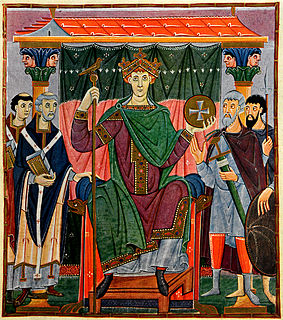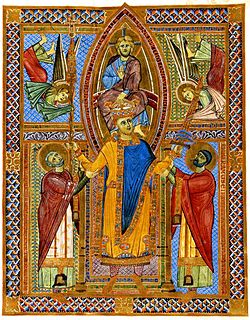Sources
- Geary, Patrick J. Before France and Germany. Oxford University Press: 1988.
| | This article about a French Catholic bishop or archbishop is a stub. You can help Wikipedia by expanding it. |
Savaric (died 715) was the Bishop of Auxerre from 710 until his death. A member of high nobility, he was a warrior who held a bishopric. He was the father of Eucherius, Bishop of Orleans.
He gathered a large army and subjected the region of the Nivernais, Avallonais, and Tonnerre to his rule during the reigns of Childebert III and Dagobert III. He marched a large army on Lyon but died in battle.
| | This article about a French Catholic bishop or archbishop is a stub. You can help Wikipedia by expanding it. |

The Ottonian dynasty was a Saxon dynasty of German monarchs (919–1024), named after three of its kings and Holy Roman Emperors named Otto, especially its first Emperor Otto I. It is also known as the Saxon dynasty after the family's origin in the German stem duchy of Saxony. The family itself is also sometimes known as the Liudolfings, after its earliest known member Count Liudolf and one of its primary leading-names. The Ottonian rulers were successors of the Germanic king Conrad I who was the only Germanic king to rule in East Francia after the Carolingian dynasty and before this dynasty.
Pope Clement II, was bishop of Rome and ruler of the Papal States from 25 December 1046 until his death in 1047. He was the first in a series of reform-minded popes from Germany. Suidger was the bishop of Bamberg. In 1046, he accompanied King Henry III of Germany, when at the request of laity and clergy of Rome, Henry went to Italy and summoned the Council of Sutri, which deposed Benedict IX and Sylvester III, and accepted the resignation of Gregory VI. Henry suggested Suidger as the next pope, and he was then elected, taking the name of Clement II. Clement then proceeded to crown Henry as emperor. Clement's brief tenure as pope saw the enactment of more stringent prohibitions against simony.

Year 885 (DCCCLXXXV) was a common year starting on Friday of the Julian calendar.

Otto III was Holy Roman Emperor from 996 until his early death in 1002. A member of the Ottonian dynasty, Otto III was the only son of the Emperor Otto II and his wife Theophanu.

Year 1056 (MLVI) was a leap year starting on Monday of the Julian calendar.

Otto II, called the Red (Rufus), was Holy Roman Emperor from 973 until his death in 983. A member of the Ottonian dynasty, Otto II was the youngest and sole surviving son of Otto the Great and Adelaide of Italy.

The Wars of Scottish Independence were a series of military campaigns fought between the Kingdom of Scotland and the Kingdom of England in the late 13th and early 14th centuries.

The Third Crusade (1189–1192) was an attempt by the leaders of the three most powerful states of Western Christianity to reconquer the Holy Land following the capture of Jerusalem by the Ayyubid sultan Saladin in 1187. It was partially successful, recapturing the important cities of Acre and Jaffa, and reversing most of Saladin's conquests, but it failed to recapture Jerusalem, which was the major aim of the Crusade and its religious focus.

The Battle of Varna took place on 10 November 1444 near Varna in eastern Bulgaria. The Ottoman Army under Sultan Murad II defeated the Hungarian–Polish and Wallachian armies commanded by Władysław III of Poland, John Hunyadi and Mircea II of Wallachia. It was the final battle of the Crusade of Varna.

Valdemar II, called Valdemar the Victorious or Valdemar the Conqueror, was the King of Denmark from 1202 until his death in 1241. The nickname Sejr is a later invention and was not used during the King's own lifetime. Sejr means victory in Danish.

Leo II, also Leon II, Levon II or Lewon II, was the tenth lord of Armenian Cilicia or “Lord of the Mountains” (1187–1198/1199), and the first king of Armenian Cilicia (1198/1199–1219). During his reign, Leo succeeded in establishing Cilician Armenia as a powerful and a unified Christian state with a pre-eminence in political affairs. Leo eagerly led his kingdom alongside the armies of the Third Crusade and provided the crusaders with provisions, guides, pack animals and all manner of aid. Under his rule, Armenian power in Cilicia was at its apogee: his kingdom extended from Isauria to the Amanus Mountains.

The County of Holland was a State of the Holy Roman Empire and from 1432 part of the Burgundian Netherlands, from 1482 part of the Habsburg Netherlands and from 1581 onward the leading province of the Dutch Republic, of which it remained a part until the Batavian Revolution in 1795. The territory of the County of Holland corresponds roughly with the current provinces of North Holland and South Holland in the Netherlands.

Arduin was an Italian nobleman who was King of Italy from 1002 until 1014.
Dirk III was Count of Holland from 993 to 27 May 1039, until 1005 under regency of his mother. It is thought that Dirk III went on pilgrimage to the Holy Land around 1030, hence his nickname of Hierosolymita.

Herman(n) of Salm, also known as Herman(n) of Luxembourg, the progenitor of the House of Salm, was Count of Salm and elected German anti-king from 1081 until his death.

Friese Freedom or Freedom of the Frisians was the absence of feudalism and serfdom in Frisia, the area that was originally inhabited by the Frisians. Historical Frisia included the modern provinces of Friesland and Groningen, and the area of West Friesland, in the Netherlands, and East Friesland in Germany. During the period of Frisian freedom the area did not have a sovereign lord who owned and administered the land. The freedom of the Frisians developed in the context of ongoing disputes over the rights of local nobility.

Farciennes Castle is a derelict 17th-century castle in Farciennes in the province of Hainaut, Belgium. The present building stands on the site of an earlier castle of the 14th century.

Henry IV was Holy Roman Emperor from 1084 to 1105, King of Germany from 1054 to 1105, King of Italy and Burgundy from 1056 to 1105, and Duke of Bavaria from 1052 to 1054. He was the son of Henry III, Holy Roman Emperor—the second monarch of the Salian dynasty—and Agnes of Poitou. After his father's death on 5 October 1056, Henry was placed under his mother's guardianship. She made grants to German aristocrats to secure their support. Unlike her late husband, she could not control the election of the popes, thus the idea of the "liberty of the Church" strengthened during her rule. Taking advantage of her weakness, Archbishop Anno II of Cologne kidnapped Henry in April 1062. He administered Germany until Henry came of age in 1065.

Henry III, called the Black or the Pious, was Holy Roman Emperor from 1046 until his death in 1056. A member of the Salian Dynasty, he was the eldest son of Emperor Conrad II of Germany and Gisela of Swabia.

Henry II, also known as Saint Henry the Exuberant, Obl. S. B., was Holy Roman Emperor from 1014. He died without an heir in 1024, and was the last ruler of the Ottonian line. As Duke of Bavaria, appointed in 995, Henry became King of the Romans following the sudden death of his second cousin, Emperor Otto III in 1002, was made King of Italy in 1004, and crowned emperor by Pope Benedict VIII in 1014.